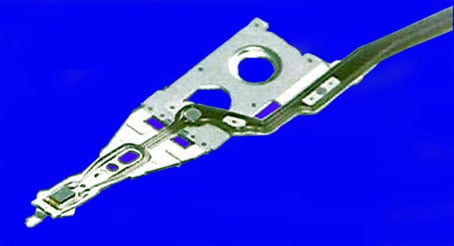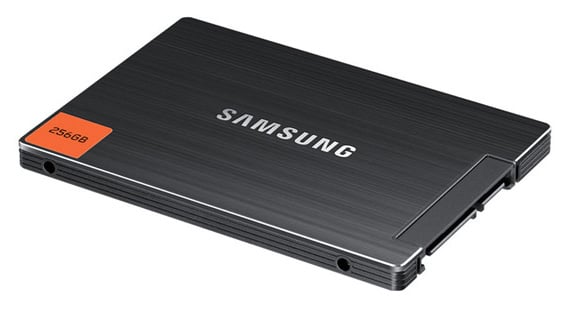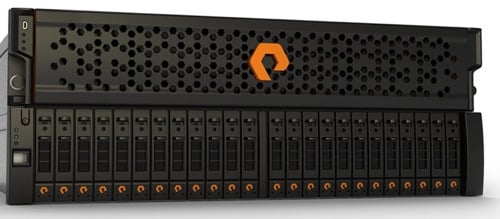e.Digital
Will the titans of storage decide to flash their bits?
What religion do you suppose the Pope is
By Chris Mellor
Posted in Storage, 16th July 2012 07:00 GMT
The fundamental decision facing most of the online storage industry is whether to use spinning or flashing bits or both. Flashing bit growth, solid state NAND storage, is booming and set to grow strongly. Why aren't Seagate, Toshiba and Western Digital, the spinning disk-supplying tri-opoly, as successful with flash drives as OCZ, LSI, Micron, SanDisk, Fusion-io and other flash storage suppliers? How come Toshiba is making more headway than Seagate and Western Digital?
The three spinning disk drive bit storage suppliers face the classic incumbent's dilemma; welcome the new flash technology or fight it. So far they are really welcoming it - Toshiba, offering it a middling welcome - Seagate, which is delivering Pulsar SSDs and also hybrid disk drives, ones with an on-board flash cache, and a guarded, half-hearted welcome - Western Digital, with a niche embedded SSD business; what you might call a bear-hug from one, a handshake from another, and a brief nod of the head from the third.

Overview of the flash industry - this is not an exhaustive list.
There are three disk drive suppliers; Seagate, Toshiba and Western Digital. There are four main flash chip suppliers; Samsung, Toshiba, Micron and Hynix; yes, you spotted it; Toshiba is in both groups; it is the bear-hugger. All six of these suppliers make flash drives, that is solid state drives (SSDs) packaged in disk bay sizes with disk type interfaces - FC, SAS and SATA, or PCIe flash cards.
To understand the background to what is happening let's take a whistle-stop tour of the spinning and flashing drive industries and manufacturing operations.
Spinning disk industry
The spinning disk triumvirate manufactures one of the most fabulously complex pieces of electro-mechanical tech in the world and does so to the tune of tens of millions of drives a year. It embodies hi-tech down to a molecular scale, mechanisms that boggle the mind, and firmware performing signal processing and error detection and correcting algorithms of mind-bending complexity at lightning speed.

A drive consists of glass or aluminium platters coated with a recording media layer and spun by an electric motor. A read/write head with semi conductor technology at its tip is mounted on an arm and moves across and above the surfaces of the spinning platters, reading and writing bits. A controller does all the processing needed for this, understanding disk tracks and sectors, decoding and error-correcting read signals and sending./receiving bits to the connected host computer.
Disk drives are made in a set of disparate plants; the platters in one, the reads/write heads in another, the controllers in a third, and assembly and test in a fourth type of plant. Each of these type of plants has a network of component suppliers feeding it. The industry is generally vertically integrated but not to the extent of having single mega-plants with glass, aluminium, and silicon going in one end and disk drives coming out of the other. There are independent head producers, like TDK, and independent platter and electric motor producers. There are also independent controller function producers, such as LSI.

Disk read/write head
This is a difference with the flash drive industry which has a simpler manufacturing model.
Flash threat to disk
Disk drives take time to find data; the head has to go across the disk to the right track and then the disk has to rotate to bring the write section of the track under the read head. A flash drive responds hundreds of time faster than a disk drive but costs a lot more. By storing data on many spindles a disk array can stream data at roughly the same rate as a flash drive but that brings the cost of the disk storage up.
Solid state drives (SSDs) as the choice when the number of IO operations per second (IOPS) is paramount. SSDs can also whup disks in the space, power and cooling stakes, being smaller, needing less electricity and running cooler for a given number of IOPS. The effect if this is being seen in the virtual collapse of the 1.8-inch hard disk drive (HDD) industry, and the encroaching of SSDS into storage arrays to replace fast Fibre Channel and SAS disk drives, the 15,000rpm drives, in high IOPS applications.

Samsung SSD
SSDs are also being used in thin and light notebook and ultrabook computers because they are, obviously, lighter, start-up and run applications faster, and have a longer battery life. As flash storage becomes cheaper over time the threat will extend to 10,000rpm drives and to desktop PC disk drives. Should a HDD supplier, facing this developing threat, fight the oncoming flash flood or redefine themselves and adopt flash technology, thus cannibalising their own HDD sales?
The problem is fairly long term as there simply isn't enough flash fab capacity to replace shipped HDD capacity and it will take years to build it. This removes some urgency from the situation for the two HDD suppliers lacking flash fabs; Seagate and Western Digital.
Flash industry from 20,000 feet
The flash industry is basically simple, with a two-layer model; flash fabs or foundries make chips which are incorporated into drives with controllers and firmware. It's semi-conductor based with no complex electro-mechanical components at all; solid state.
There are four main flash foundry owners and operators; market leader Samsung, second placed Toshiba, Micron and Intel with Intel Micron Flash Technologies (IMTF) which Micron dominates, and number four Hynix.
There are many flash drive suppliers in addition to the four flash fab operators and the disk drive makers, and these include Corsair, Fusion-io, LSI, OCZ, OWC, SanDisk, Plextor, SMART, STEC, TMS and Virident. Apple makes flash drives for its own use in iPads, etc. The others sell drives to all comers.
Flash controller products come from companies like Marvell and LSI.
Server flash used for caching needs caching software and this comes from the server flash drive suppliers, such as OCX with SANRAD, independents like Nevex, Proximal Data and VeloBit. Combined server flash HW and SW comes from EMC with its VFCache product, using Micron and LSI SSDs, and Dell is developing its Hermes product in the server flash cache area.
A layer up the storage stack there are networked all-flash arrays, and suppliers include GreenBytes, Kaminario, Nimbus, Pure Storage, SolidFire, TMS, Violin Memory and Whiptail. There are also flash-using NAS accelerators like Avere and CacheIQ.
Some of these suppliers use SSDs as their components; others, like Violin, use flash chips on special cards.

Pure Storage all-flash array
Samsung used to make disk drives but sold that business to Seagate. Toshiba makes disk drives and recently gained scale, buying Fujitsu's HDD operation and buying some Western Digital 3.5-inch manufacturing capacity when that company acquired Hitachi Global Storage Technologies. Toshiba has a foundry output sharing arrangement with flash drive supplier SanDisk. SanDisk recently bought a flash controller company called Pliant. In general, flash controller companies are being acquired by flash drive manufacturers.
Main disk and flash industry moves
There have been several acquisitions over recent years as the flash industry has developed. Here are the main events:-
Flash fab investments
- Samsung has bought into the server flash card industry leader Fusion-io
- Toshiba has bought into one of the flash array leaders, Violin Memory
- Hynix has bought consumer flash controller supplier Link A Media Devices (LAMD)
HDD supplier flash deals - Seagate and Samsung have a flash chip supply and controller partnership
- Western Digital bought niche embedded flash drive supplier SiliconSystems
Flash controller acquisitions
- Seagate has bought flash controller start-up DensBits
- SanDisk bought controller start-up Pliant
- LSI bought controller supplier SandForce
- OCZ bought controller supplier Indilinx
- Apple bought controller startup Anobit
Flash caching SW acquisitions
- Dell buys RNA Networks
- SanDisk buys FlashSoft for server caching SW
- Fusion-io buys IO Turbine server caching SW
- OCZ buys SANRAD for its server caching SW
- TMS deal with Nevex to use its caching SW
Conclusions we can draw
One obvious conclusion is that drive suppliers need their own in-house controller operation. Five of the moves listed above involve that activity. None of the flash fab operators have bought drive controller companies, with the recent exception of Hynix which bought Link A Media Devices (LAMD) in June. This is a potential move by the other three flash foundry owners Samsung, Toshiba and Micron.
A second conclusion is that server flash drive suppliers need caching software to load, and sometimes share, hot data into the flash drives. LSI has its CacheCade SW here and STEC has developed its own caching SW. TMS is working with Canada-based Nevex to use its CacheWorks SW. We note that Dell is developing its caching software, Hermes, using its RNA Networks acquisition, and EMC is also developing VFCache caching software integrated with its FAST array data tiering SW. NetApp has said it will cache data from its arrays in server flash cache and will need SW to do that.
None of the flash foundry owners have bought drive caching software companies and this is another potential acquisition avenue for them, if they want to supply more than a raw SSD for servers.
What should disk spinners do?
If disk manufacturers are serious about getting into the flash drive business then they have to have their own controller operation. Toshiba does. Seagate has bought DensBits for that reason. Western Digital is out in the relative controller cold with its mostly embedded SSD business. It needs to develop or buy in technology if it is to expand out of that niche.
This is a pressing issue as cheaper 3-bit per cell flash (TLC) is coming and advanced controller functionality is needed to turn its raw relatively useless working life into a product that will last for five years or so. Not having such a controller means you can't ship TLC-based drives and competitors that can will undercut you on pricing.
Secondly, the only way to get certainty of flash chip supply and intimate knowledge of flash chips, so your controller can make them perform fast and for a long time, is by having a flash fab relationship. Money is the seal on such alliances. Arguably Samsung and Seagate need to build on their alliance and have an investment go from one to the other to make the relationship as solid as it can be and incentivise both parties.
Toshiba has its investment in flash array system supplier Violin Memory. Samsung has its deal with Seagate flash drive competitor Fusion-io; although Seagate is not in the PCIe flash card market segment which Fusion-io dominates. Where is Western Digital? Out in the cold again.
Are disks the new tape and flash the new disk?
Of course, WD has been involved in a monumentally complicated Hitachi GST acquisition, and HGST ships Intel-based SSDs. This acquisition will have taken up huge amounts of exec brain power. Now that is approved and underway them it needs to point some execs' brains towards flash and get itself a flash controller company and and an investment in Hynix or Micron, either directly or through HGST, if the regulator-imposed dual and separate WD-HGST operation model permits that.
Flash fab and flash drive consolidation
If the direction of the industry is consolidation across the flash fab and flash drive sectors then it is even more important for the disk drive manufacturers to get into bed with flash foundry suppliers. Toshiba is there already with a foot in both camps, flash fabrication and HDD manufacture. Samsung, Micron and Hynix make their own flash drives and will need to be courted by potential suitor/investors saying what they will bring to the party. All three would surely appreciate the channel strength that disk drive manufacturers would bring to the party.
A third point is that server flash drive suppliers need caching software. Toshiba has indirect access via SanDisk, its foundry partner. Samsung has indirect access via Fusion-io. If Seagate and Western Digital are serious about shipping server cache then they need caching software too. Possible companies they could tie up with include Nevex, Proximal Data and VeloBit.
Seagate and WD are led by tough, seasoned executive teams who have survived the great HDD industry consolidation wars. They know that HDDS easily brushed aside online tape drives and are still brushing aside backup tape drives. They know that a faster storage media can kick out an old one and utterly change its business model. Been there; done that. No tape drive and library vendor has managed to become a successful disk array vendor, not one.
Now the faster storage medium threat faces the spinning bit device vendors. Are disks the new tape and flash the new disk?
Will these tough, clear-sighted and strong-minded executive teams read the runes, understand the history and the threats and adopt and adapt solid-state, become flash bear-huggers, do a half-hearted adoption and get by-passed, or stick their heads in the sand and wait for their asses to be kicked?
So far Toshiba is furthest along the bear-hugging road, Seagate is some way behind and, further behind still unless there are internal developments we don't know about, comes Western Digital.
Where will they be in five years time? El Reg thinks they will be charging full tilt down the flash highway, not ceding an inch to the other flash product makers. We'll see. ®
Original URL: http://www.theregister.co.uk/2012/07/16/spinning_or_flashing_bits/
Related stories
- Tosh spins up faster, longer-lasting head-turner for big biz (12 July 2012)
- The Great TLC flash cash-slash: Coming soon to tablets, Ultrabooks (11 July 2012)
- LSI lures IT vendors with Nytro blast for flash storage (9 July 2012)
-
SMART's new SSD wrings extra juice from MLC flash (9 July 2012)
http://www.theregister.co.uk/2012/07/09/smart_optimus_ultra_plus/